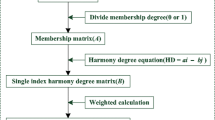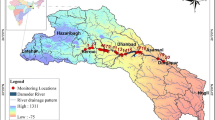Abstract
In the context of water resource management and pollution control, the characterization of water quality impairments and identification of dominant pollutants are of critical importance. In this study, water quality impairment was assessed on the basis of 7 hydrochemical variables that were monitored bimonthly at 17 sites in 2010 along the rural-suburban-urban portion of the Wen-Rui Tang River in eastern China. Seven methods were used to assess water quality in the river system. These methods included single-factor assessment, water quality grading, comprehensive pollution index, the Nemerow pollution index, principle component analysis, fuzzy comprehensive evaluation, and comprehensive water quality identification index. Our analysis showed that the comprehensive water quality identification index was the best method for assessing water quality in the Wen-Rui Tang River due to its ability to effectively characterize highly polluted waters with multiple impairments. Furthermore, a guideline for the applications of these methods was presented based on their characteristics and efficacy. Results indicated that the dominant pollutant impairing water quality was total nitrogen comprised mainly of ammonium. The temporal variation of water quality was closely related to precipitation as a result of dilution. The spatial variation of water quality was associated with anthropogenic influences (urban, industrial, and agriculture activities) and water flow direction (downstream segments experiencing cumulative effects of upstream inputs). These findings provide valuable information and guidance for water pollution control and water resource management in highly polluted surface waters with multiple water quality impairments in areas with rapid industrial growth and urbanization.




Similar content being viewed by others
References
Ban, X., Wu, Q. Z., Pan, B. Z., et al. (2014). Application of composite water quality identification index on the water quality evaluation in spatial and temporal variations: a case study in Honghu Lake, China. Environmental Monitoring and Assessment, 186, 4237–4247.
Bu, H. M., Tan, X., Li, S. Y., et al. (2010). Water quality assessment of the Jinshui River (China) using multivariate statistical techniques. Environmental Earth Sciences, 60, 1631–1639.
Chen, H. W., Chang, N. B., & Shaw, D. (2005). Valuation of in-stream water quality improvement via fuzzy contingent valuation method. Stochastic Environmental Research and Risk Assessment, 19(2), 158–171.
Cheng, J. L., Zhou, S., & Zhu, Y. M. (2007). Assessment and mapping of environmental quality in agriculture soils of Zhejiang Province, China. Journal of Environmental Sciences, 19, 50–54.
Dalal, S. G., Shirodkar, P. V., Jagtap, T. G., et al. (2010). Evaluation of significant sources influencing the variation of water quality of Kandla Creek, Gulf of Katchchh, using PCA. Environmental Monitoring and Assessment, 16, 49–56.
Dierk, W., & Michael, R. (2008). Modelling the impact of river morphology on nitrogen retention—a case study of the Weisse Elster River (Germany). Ecological Modelling, 211, 224–232.
Fu, T. Y., Zou, Z. H., & Wang, X. J. (2014). Water quality assessment for Taizi River watershed in Liaoyang section based on multivariate statistical analysis and water quality identification index. Acta Scientiae Circumstantiae, 34(2), 473–480 (in Chinese).
Helena, B., Pardo, R., Vega, M., et al. (2000). Temporal evolution of groundwater composition in an alluvial aquifer (Pisuerga River, Spain) by principal component analysis. Water Research, 34, 807–816.
Holloway, J. M., Dahlgren, R. A., Hansen, B., et al. (1998). Contribution of bedrock nitrogen to high nitrate concentrations in stream water. Nature, 395, 785–788.
Hope, C., Parker, J., & Peake, S. (1992). A pilot environmental index for the UK in the 1980s. Energy Policy, 20, 335–343.
Houser, J. N., & Richardson, W. B. (2010). Nitrogen and phosphorous in the Upper Mississippi River: transport, processing, and effects on the river ecosystem. Hydrobiologia, 640, 71–88.
Huang, F., Wang, X. Q., Lou, L. P., et al. (2010). Spatial variation and source apportionment of water pollution in Qiantang River (China) using statistical techniques. Water Research, 44, 1562–1572.
Khanna, N. (2000). Measuring environmental quality: an index of pollution. Ecological Economics, 35, 191–202.
Li, S., & Zhang, Q. (2010). Spatial characterization of dissolved trace elements and heavy metals in the upper Han River (China) using multivariate statistical techniques. Journal of Hazardous Materials, 176, 579–588.
Liu, X. Z., Heilig, G. K., Chen, J. M., et al. (2007). Interactions between economic growth and environmental quality in Shenzhen, China’s first special economic zone. Ecological Economics, 62, 559–570.
Lu, R. S., & Lo, S. L. (2002). Diagnosing reservoir water quality using self-organizing maps and fuzzy theory. Water Research, 36, 2265–2274.
Lu, P., Mei, K., Zhang, Y. J., et al. (2011). Spatial and temporal variations of nitrogen pollution in Wen-Rui Tang River watershed, Zhejiang, China. Environmental Monitoring and Assessment, 180, 501–520.
Massoud, M. A. (2012). Assessment of water quality along a recreational section of the Damour River in Lebanon using the water quality index. Environmental Monitoring and Assessment, 184, 4151–4160.
Mei, K., Liao, L. L., Zhu, Y. L., et al. (2014). Evaluation of spatial-temporal variations and trends in surface water quality across a rural-suburban-urban interface. Environmental Science and Pollution Research, 21, 8036–8051.
Morse, N. B., & Wollheim, W. M. (2014). Climate variability masks the impacts of land use change on nutrient export in a suburbanizing watershed. Biogeochemistry, 121, 45–59.
National Research Council (NRC). (2001). Assessing the TMDL approach to water quality management. Washington, D C: National Academy Press.
Phung, D., Huang, C. R., Rutherford, S., et al. (2015). Temporal and spatial assessment of river surface water quality using multivariate statistical techniques: a study in Can Thi City, a Mekong Delta area, Vietnam. Environmental Monitoring and Assessment, 187, 229.
Shin, J. Y., Artigas, F., Hobble, C., et al. (2013). Assessment of anthropogenic influences on surface water quality in urban estuary, northern New Jersey: multivariate approach. Environmental Monitoring and Assessment, 185, 2777–2794.
Shrestha, S., & Kazama, F. (2007). Assessment of surface water quality using multivariate statistical techniques: a case study of the Fuji River basin, Japan. Environmental Modeling and Software, 22, 464–475.
Simeonov, V., Stratis, J. A., Samara, C., et al. (2003). Assessment of the surface water quality in northern Greece. Water Research, 37, 4119–4124.
Singh, K. P., Malik, A., Mohan, D., et al. (2004). Multivariate statistical techniques for the evaluation of spatial and temporal variations in water quality of Gomti River (India)—a case study. Water Research, 38, 3980–3992.
Singh, K. P., Basant, N., & Gupta, S. (2011). Support vector machines in water quality management. Analytical Chimca Acta, 703, 152–162.
Wang, X. Z., & Wang, P. (2011). The application and analysis of several appraisal methods for river water quality in Huairou reservoir. Beijing Water, 1, 31–33 (in Chinese).
Xu, Z. X. (2005). Comprehensive water quality identification index for environmental quality assessment of surface water. Journal of Tongji University (Natural Science), 33, 482–488 (in Chinese).
Yang, L. P., Mei, K., Liu, X. M., et al. (2013). Spatial distribution and source apportionment of water pollution in different administrative zones of Wen-Rui-Tang river watershed (WRT), China. Environmental Science and Pollution Research, 20, 5341–5352.
Zhejiang Environmental Protection Bureau (ZEPB). (2010). Scheme for river function zoning and water environment zoning of Zhejiang Province document of Zhejiang Government. (in Chinese)
Acknowledgements
The authors would like to acknowledge the funding support from a project of the Science and Technology Department of Zhejiang Province (award number 2008C03009). We are also thankful to the Wenzhou Environmental Protection Agency for the data provided for the Wen-Rui Tang River.
Author information
Authors and Affiliations
Corresponding author
Appendices
Appendix A
Appendix B
Rights and permissions
About this article
Cite this article
Ji, X., Dahlgren, R.A. & Zhang, M. Comparison of seven water quality assessment methods for the characterization and management of highly impaired river systems. Environ Monit Assess 188, 15 (2016). https://doi.org/10.1007/s10661-015-5016-2
Received:
Accepted:
Published:
DOI: https://doi.org/10.1007/s10661-015-5016-2




